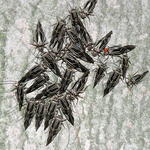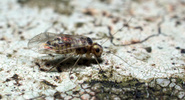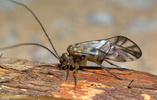Psocetae
Bark Lice
Emilie Bess and Kevin P. Johnson


This tree diagram shows the relationships between several groups of organisms.
The root of the current tree connects the organisms featured in this tree to their containing group and the rest of the Tree of Life. The basal branching point in the tree represents the ancestor of the other groups in the tree. This ancestor diversified over time into several descendent subgroups, which are represented as internal nodes and terminal taxa to the right.

You can click on the root to travel down the Tree of Life all the way to the root of all Life, and you can click on the names of descendent subgroups to travel up the Tree of Life all the way to individual species.
For more information on ToL tree formatting, please see Interpreting the Tree or Classification. To learn more about phylogenetic trees, please visit our Phylogenetic Biology pages.
close boxIntroduction
Infraorder Psocetae includes the families Hemipsocidae, Myopsocidae, Psilopsocidae, and Psocidae, which comprise about 70 genera and 1100 species worldwide. These bark lice live in dead foliage, on bark, or on stone surfaces. They are 2-8 mm long and eat lichens, algae, and fungus.
Characteristics
Synapomorphies
- Legs:
- hind tibiae have ctenidia-based broad setae.
- Wing:
- membranes are hairless.
- Female:
- egg guide is single-lobed and extends from the ventral margin of the subgenital plate.
General Characters
- Head:
- Vertex is rounded.
- Postclypeus is less bulged than in other Psocomorpha.
- Internal ridge of epistomal suture is narrow (absent in Hemipsocidae).
- Anteclypeus is sclerotized.
- Eyes are usually much larger on males than on females.
- Ocelli present and are not clustered on small tubercle.
- Mandibles are short with the outer margin smoothly rounded and the posterolateral margin not hollowed.
- Lacinial tip is variable.
- Galea is flattened.
- Labial palpi are rounded.
- Thorax:
- Prothorax is less bulged dorsally than in other Psocomorpha.
- Pterothorax is well bulged dorsally.
- Mesoscutellum is pentagonal medially.
- Mesothorax has a narrow precoxal bridge and broad trochantin.
- Metaepisternum has a broad membranous region.
- Legs:
- Hind tarsus has a row of broad ctenidia based hairs (condition unknown in Psilopsocidae).
- Tarsi have 2 or 3 segments.
- Tarsal claws have a preapical tooth.
- Pulvillus is broad or narrow (Psocidae).
- Wings:
- Forewing:
- Forewing often has dark brown markings.
- Posteroproximal corner of forewing is smoothly rounded.
- Veins and wing margins are usually hairless.
- Vein CuA1 is usually connected with M except free in Psilopsocidae.
- Vein A2 is never present.
- Hindwing:
- Hindwing is hairless.
- Posteroproximal corner of hindwing is smoothly rounded.
- Vein Sc clear is clear.
- Veins Rs, M, and Cu are fused for long distance basally.
- Veins Rs and M are fused or connected by crossvein (some genera in Myopsocidae).
- Abdomen:
- Abdomen lacks eversible vesicles.
- Male genitalia:
- Paraproct has process on distal margin.
- Hypandrium usually has a complex distal processes or lobes.
- Phallosome varies, internal valve present or absent, external valve often absent.
- Endophallus lacks sclerotized portion.
- Female genitalia:
- Paraproct has a cylindrical distal projection.
- Subgenital plate has a 1-lobed egg guide extending from ventral margin.
- Apex of egg guide usually has some hairs.
- Gonapophyses are complete and variable in structure:
- External valve is internally expanded.
Discussion of Phylogenetic Relationships
The monophyly of the four families of Psocetae is strongly supported with molecular data (mtDNA genes 12S, 16S, and COI, and 18S rDNA; Johnson & Mockford 2003, Johnson et al. 2004). Morphological data, however, led Yoshizawa (2002) to exclude Hemipscoidae from the infraorder. He erected the infraorder Hemipsocetae to include Hemipsocidae alone, based on four characters: absence of the epistomal suture, broadened first axillary sclerite, two-branched M vein in forewing, and CuA1-M crossvein in forewing.
The classification used here is based on molecular data and places family Hemipsocidae as sister to family Psilopsocidae within infraorder Psocetae (18S rDNA; Johnson et al. 2004).
References
Johnson, K. P. & E. L. Mockford. 2003. Molecular systematics of Psocomorpha (Psocoptera). Systematic Entomology 28: 409-40
Johnson, K. P., K. Yoshizawa, and V. S. Smith. 2004. Multiple origins of parasitism in lice. Proceeding of the Royal Society of London B 271: 1771-1776.
Lienhard, C. and C. N Smithers. 2002. Psocoptera (Insecta) World Catalogue and Bibliography. Muséum d'Histoire Naturelle, Geneva, Switzerland.
Mockford, E. L. 1993. North American Psocoptera (Insecta). Gainesville, Florida: Sandhill Crane Press.
Mockford, E. L. 2005. Order Psocoptera: Psocids. Pp. 341-355 in C. A. Triplehorn and n. F. Johnson (eds.) Borror and DeLong's Introduction to the Study of Insects. Belmont, California: Thomson Publishing.
Smithers, C. N. 1996. Psocoptera. Pp. 1-80, 363-372 (Index) in A. Wells (ed.) Zoological Catalogue of Australia. Vol. 26. Psocoptera, Phthiraptera, Thysanoptera. Melbourne: CSIRO Publishing, Australia.
Yoshizawa, K. 2002. Phylogeny and higher classification of suborder Psocomorpha (Insecta: Psocodea:'Psocoptera'). Zoological Journal of the Linnean Society 136: 371-400.
Yoshizawa, K. 2005. Morphology of Psocomorpha (Psocodea: 'Psocoptera'). Insecta Matsumurana 62: 1-44.
Title Illustrations

| Scientific Name | Blaste sp. |
|---|---|
| Location | Nokonoshima Island, Kyushu, Japan |
| Specimen Condition | Live Specimen |
| Identified By | K. Yoshizawa |
| Life Cycle Stage | adult |
| View | dorsal |
| Size | 3mm |
| Copyright | © 2006 Kazunori Yoshizawa |
| Scientific Name | Cerastipsocus venosus |
|---|---|
| Location | Vernon, Vt. |
| Specimen Condition | Live Specimen |
| Behavior | aggregation |
| Life Cycle Stage | nymphs |
| View | dorsal |
| Copyright | © Tom Murray |
| Scientific Name | Psococerastis sp. |
|---|---|
| Specimen Condition | Live Specimen |
| Identified By | K. Yoshizawa |
| Life Cycle Stage | adult |
| View | lateral |
| Size | 4mm |
| Copyright | © 2006 Kazunori Yoshizawa |
About This Page
Emilie Bess

Illinois Natural History Survey, Champaign, Illinois, USA
Kevin P. Johnson

Illinois Natural History Survey, Champaign, Illinois, USA
Correspondence regarding this page should be directed to Emilie Bess at and Kevin P. Johnson at
Page copyright © 2009 Emilie Bess and Kevin P. Johnson
All Rights Reserved.
- First online 11 October 2006
- Content changed 25 March 2009
Citing this page:
Bess, Emilie and Kevin P. Johnson. 2009. Psocetae. Bark Lice. Version 25 March 2009 (under construction). http://tolweb.org/Psocetae/30220/2009.03.25 in The Tree of Life Web Project, http://tolweb.org/











 Go to quick links
Go to quick search
Go to navigation for this section of the ToL site
Go to detailed links for the ToL site
Go to quick links
Go to quick search
Go to navigation for this section of the ToL site
Go to detailed links for the ToL site